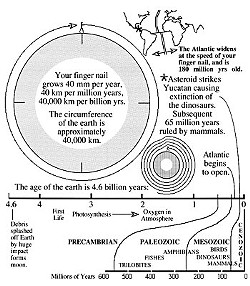[
{
"name": "Top Stories Video Pair",
"insertPoint": "7",
"component": "17087298",
"parentWrapperClass": "fdn-ads-inline-content-block",
"requiredCountToDisplay": "1"
}
]
Geologic time was involved in my previous articles on earthquakes, marine terraces, photosynthesis and changing climates. I contend that grasping the immensity of geologic time is a prerequisite to a real understanding of our planet and its life. Twenty thousand years ago, Canada was buried under three kilometers of ice and sea level was 140 meters lower. Two hundred million years ago, Gondwanaland was still intact, there was no Atlantic Ocean, and the Jurassic was young. Two billion years ago, amoebas were our most advanced animals as oxygen began to accumulate in the atmosphere.
To assist your mind in grasping such enormous expanses of time, consider the rate at which a finger nail grows, 40 mm per year. After one million years it would be 40 km long (Rio Dell to Arcata). After one billion years it would encircle the globe, 40,000 km. Our Earth is 4.6 billion years old, a third the age of the Universe. Can you see your finger nail growing?
If you now realize that geologic time is too vast to truly comprehend, then you are primed to understand the evolution of our planet and its life.
Enjoy your holidays, and I hope the year 4,600,002,008 is kind to you.
Speaking of Science
-

HSU Expanding Curriculum with Polytechnic Push
Jun 15, 2021 -

Davos Won't Save Us
Jan 23, 2020 -

The Need to Study Weed
Jan 16, 2020 - More »
more from the author
-
Nuclear Matters
- May 6, 2010
-
Sophie Smells a Shaker
- Feb 4, 2010
-
The Roots of Love
- Feb 5, 2009
- More »
































